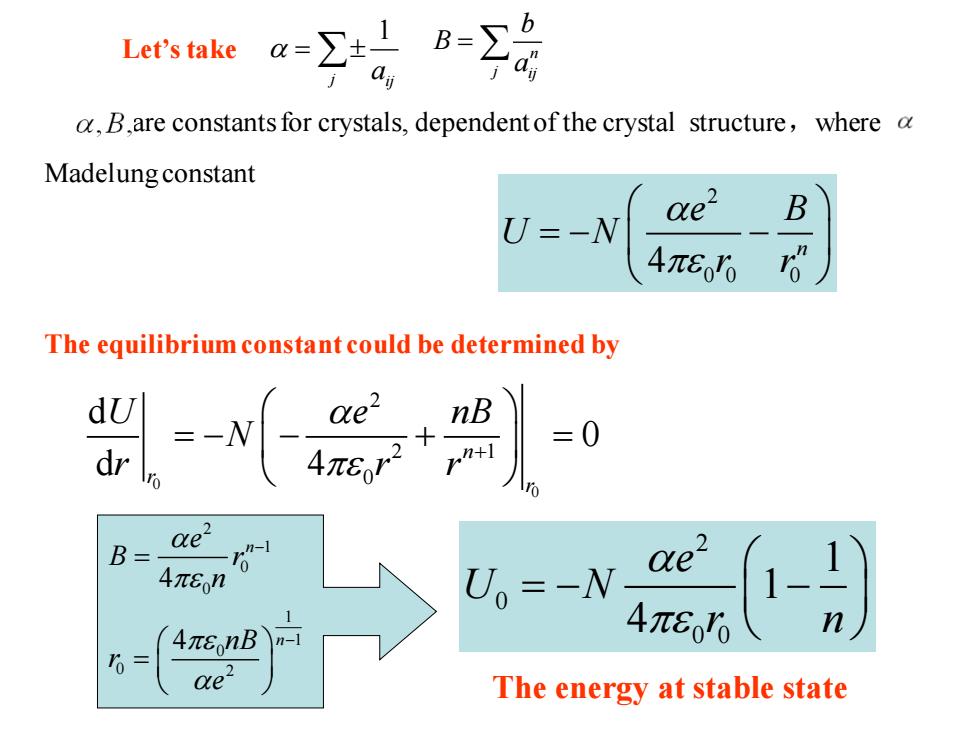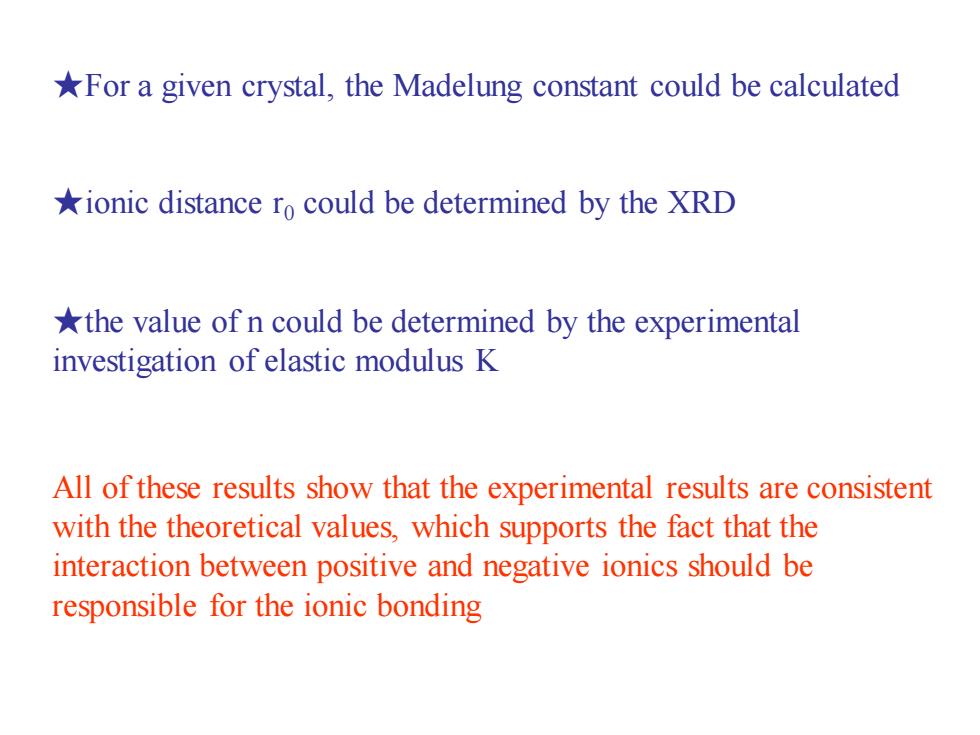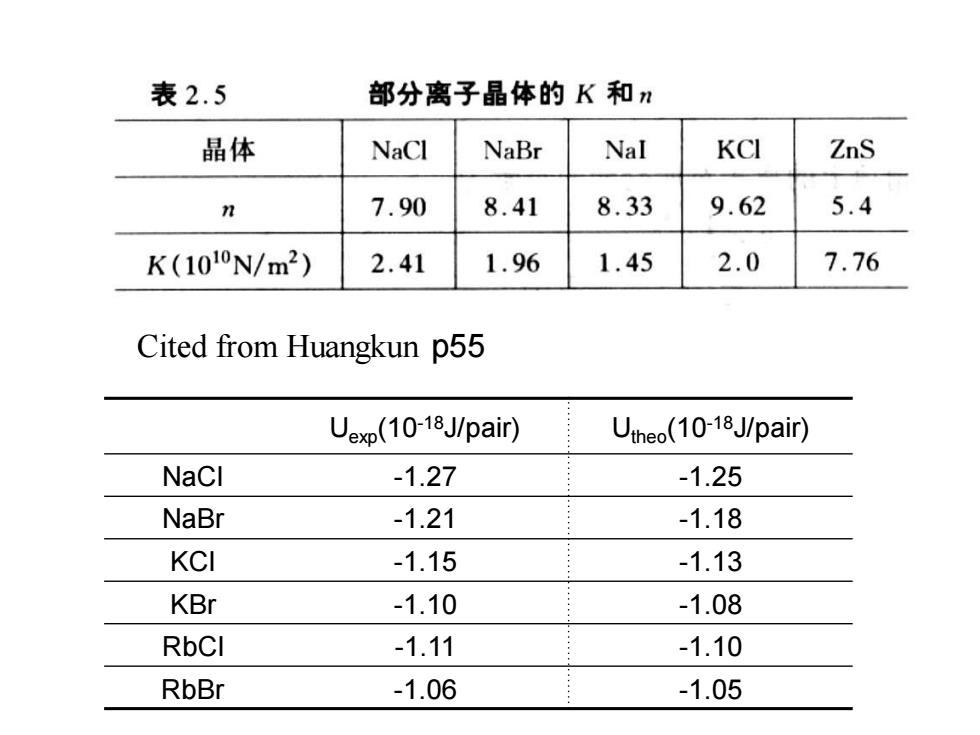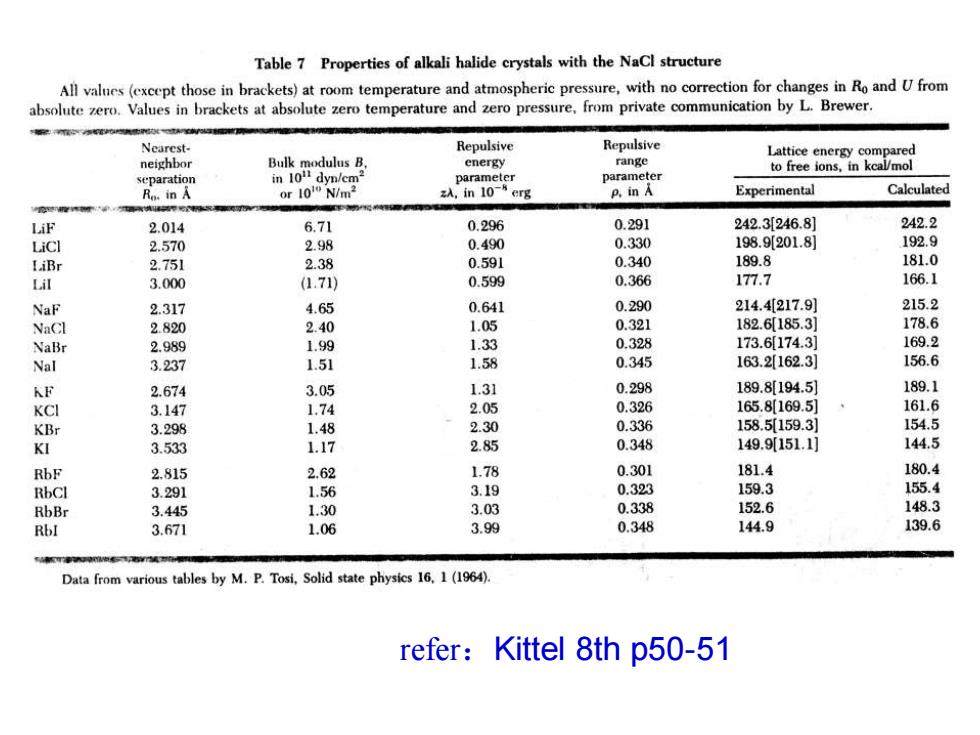
3.3 The cohesive energy for ionic crystal For NaCl,the interaction energy for two ionics could be written a尽无法显示该国片, u(r)=± e+ b 4πEor For crystal with N atoms,the interactionenergy could be wy Positive for the same charge,and negative for opposite charge If 1 The shortest distance between two ionics,taken as the unit distance U=-N e 4πEo6j
3.3 The cohesive energy for ionic crystal For NaCl, the interaction energy for two ionics could be written as 2 0 ( ) 4 ij n e b u r r r = + 0 ij ij 2 j 1 (2 ) 2 4 n e b U N r r = + Positive for the same charge, and negative for opposite charge If ij ij 0 r a r = The shortest distance between two ionics, taken as the unit distance 0 r 2 0 0 0 1 1 4 n n j j ij ij e b U N r a r a = − − For crystal with N atoms, the interaction energy could be

Let's take a,B,are constants for crystals,dependent of the crystal structure,where Madelung constant B U=-N Qe2 4π8% The equilibrium constant could be determined by B、 ae 4πn 4πEonB ae2 The energy at stable state
2 0 0 0 4 n e B U N r r = − − 2 0 0 0 1 1 4 e U N r n = − − 0 0 2 2 1 0 d 0 d 4 n r r U e nB N r r r + = − − + = 2 1 0 0 1 1 0 0 2 4 4 n n e B r n nB r e − − = = The energy at stable state 1 j ij a = n j ij b B a Let’s take = are constants for crystals, dependent of the crystal structure,where Madelung constant The equilibrium constant could be determined by

*For a given crystal,the Madelung constant could be calculated *ionic distance ro could be determined by the XRD *the value of n could be determined by the experimental investigation of elastic modulus K All of these results show that the experimental results are consistent with the theoretical values,which supports the fact that the interaction between positive and negative ionics should be responsible for the ionic bonding
★For a given crystal, the Madelung constant could be calculated ★ionic distance r0 could be determined by the XRD ★the value of n could be determined by the experimental investigation of elastic modulus K All of these results show that the experimental results are consistent with the theoretical values, which supports the fact that the interaction between positive and negative ionics should be responsible for the ionic bonding

表2.5 部分离子晶体的K和n 晶体 NaCl NaBr Nal KCI ZnS n 7.90 8.41 8.33 9.62 5.4 K(1010N/m2) 2.41 1.96 1.45 2.0 7.76 Cited from Huangkun p55 Uexp(10-18J/pair)) Utheo(10-1J/pair) NaCl -1.27 -1.25 NaBr -1.21 -1.18 KCI -1.15 -1.13 KBr -1.10 -1.08 RbCI -1.11 -1.10 RbBr -1.06 -1.05
Uexp(10-18J/pair) Utheo(10-18J/pair) NaCl -1.27 -1.25 NaBr -1.21 -1.18 KCl -1.15 -1.13 KBr -1.10 -1.08 RbCl -1.11 -1.10 RbBr -1.06 -1.05 Cited from Huangkun p55

Table 7 Properties of alkali halide crystals with the NaCl structure All values(except those in brackets)at room temperature and atmospheric pressure,with no correction for changes in Ro and U from absolute zero.Values in brackets at absolute zero temperature and zero pressure,from private communication by L.Brewer. Nearest- Repulsive Repulsive Lattice energy compared neighbor Bulk modulus B. energy range to free ions,in kcal/mol in 1011 dyn/em? parameter parameter or 1010 N/m2 zA,in 10-"erg p.in A Experimental Calculated LiF 2.014 6.71 0.296 0.291 242.3[246.8] 242.2 LiC] 2.570 2.98 0.490 0.330 198.9[201.8] 192.9 LiBr 2.751 2.38 0.591 0.340 189.8 181.0 Lil 3.000 (1.71) 0.599 0.366 177.7 166.1 NaF 2.317 4.65 0.641 0.290 214.4[217.9 215.2 NaCl 2.820 2.40 1.05 0.321 182.6185.3] 178.6 NaBr 2.989 1.99 1.33 0.328 173.6174.3] 169.2 Nal 3.237 1.51 1.58 0.345 163.2162.3] 156.6 KF 2.674 3.05 1.31 0.298 189.8[194.5] 189.1 KCI 3.147 1.74 2.05 0.326 165.8169.5] 161.6 KBr 3.298 1.48 2.30 0.336 158.5[159.3] 154.5 KI 3.533 1.17 2.85 0.348 149.9151.1] 144.5 RbF 2.815 2.62 1.78 0.301 181.4 180.4 RbCl 3.291 1.56 3.19 0.323 159.3 155.4 RbBr 3.445 1.30 3.03 0.338 152.6 148.3 RbI 3.671 1.06 3.99 0.348 144.9 139.6 Data from various tables by M.P. Tosi, Solid state physics 16.1(1964) refer:Kittel 8th p50-51
refer:Kittel 8th p50-51